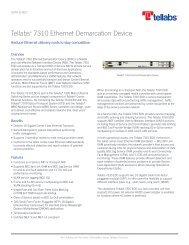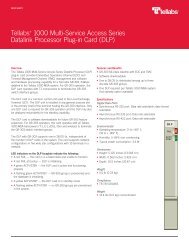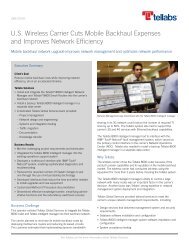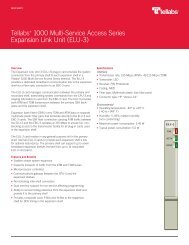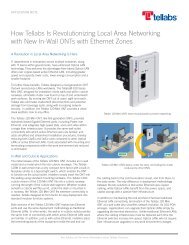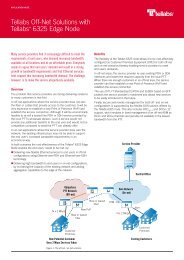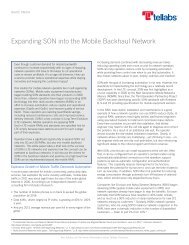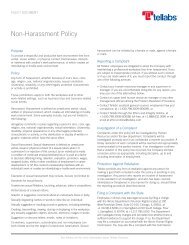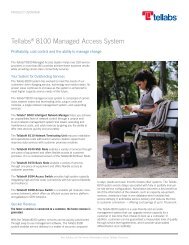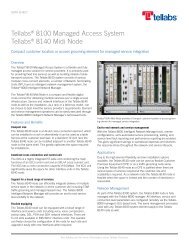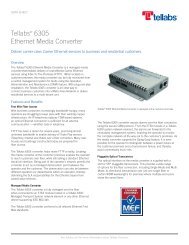Meet the Needs of LTE Backhaul with the Tellabs 8600 Smart Routers
Meet the Needs of LTE Backhaul with the Tellabs 8600 Smart Routers
Meet the Needs of LTE Backhaul with the Tellabs 8600 Smart Routers
You also want an ePaper? Increase the reach of your titles
YUMPU automatically turns print PDFs into web optimized ePapers that Google loves.
APPLICATION NOTE<br />
<strong>Meet</strong> <strong>the</strong> <strong>Needs</strong> <strong>of</strong> <strong>LTE</strong> <strong>Backhaul</strong> <strong>with</strong> <strong>the</strong><br />
<strong>Tellabs</strong> ® <strong>8600</strong> <strong>Smart</strong> <strong>Routers</strong><br />
The introduction <strong>of</strong> <strong>LTE</strong> changes <strong>the</strong> nature and requirements <strong>of</strong><br />
mobile backhaul networks. As operators evolve <strong>the</strong>ir networks to<br />
Long Term Evolution (<strong>LTE</strong>), <strong>the</strong>y need a backhaul network that<br />
enables more capacity and flexibility — not one that becomes a<br />
bottleneck. To maximize efficiency, operators should address <strong>the</strong>se<br />
requirements as <strong>the</strong>y’re planning and deploying a new backhaul<br />
network.<br />
<strong>LTE</strong> backhaul networks must provide great flexibility while meeting<br />
<strong>the</strong> scalability and operational requirements for traffic aggregation<br />
in large radio access networks. This application note highlights <strong>the</strong><br />
main requirements for <strong>LTE</strong>, and some ways to address <strong>the</strong>m.<br />
New <strong>LTE</strong> Architecture Brings Both Benefits and<br />
Challenges<br />
Traditional TDM-based transport technologies are not cost-efficient<br />
for <strong>LTE</strong> backhaul, which delivers tremendous, wireline-like speeds to<br />
<strong>the</strong> end user. So, operators are migrating to IP.<br />
<strong>LTE</strong> architecture is based on <strong>the</strong> concept <strong>of</strong> a flat IP architecture.<br />
So, <strong>the</strong> roles <strong>of</strong> <strong>the</strong> Radio Network Controller (RNC), Serving GPRS<br />
Support Node (SGSN) and Gateway GPRS Support Node (GGSN)<br />
have been redistributed to <strong>the</strong> <strong>LTE</strong> Core and <strong>the</strong> radios. As shown<br />
in Figure 1, <strong>the</strong> RNC functions in <strong>LTE</strong> networks move to <strong>the</strong> eNB. The<br />
SGSN functions are split into <strong>the</strong> Mobility Management Entity (MME) for<br />
control plane traffic and <strong>the</strong> Serving Gateway (S-GW) for user plane.<br />
In this new architecture, all <strong>the</strong> traffic is carried over IP. This leads to<br />
<strong>the</strong> implementation <strong>of</strong> new interfaces (S1 and X2), while <strong>the</strong> Iub and<br />
Iu interfaces for UMTS R99 disappear.<br />
GEOGRAPHICAL DISTRIBUTION<br />
BTS<br />
Abis<br />
BSC<br />
Figure 1: RAN Architectures for Data Traffic in 2G, 3G and <strong>LTE</strong><br />
lu<br />
SG SN<br />
NB<br />
Access<br />
1ub<br />
Level 2<br />
aggregation<br />
RNC<br />
Level 1<br />
aggregation<br />
lu<br />
Core<br />
MME<br />
S/P-<br />
GW<br />
EPC<br />
eNB<br />
X2<br />
S1-U<br />
S1-MME<br />
New Requirements for <strong>LTE</strong> <strong>Backhaul</strong><br />
The new, flat, IP architecture in <strong>LTE</strong> networks brings a new set <strong>of</strong><br />
requirements for backhaul networks. Packet forwarding by <strong>the</strong><br />
communicating Radio Access Network (RAN) devices (MMEs,<br />
S/P-GWs, eNBs) is based on Layer 3 (L3) IP addressing. This is<br />
supported by various underlying infrastructures. Additionally, <strong>the</strong><br />
architecture in <strong>LTE</strong> is no longer strictly a point-to-point topology<br />
like in 3G networks. <strong>LTE</strong> networks need more diverse connectivity<br />
between <strong>the</strong> RAN network elements. The flat IP architecture and <strong>the</strong><br />
absence <strong>of</strong> an RNC also create a need for providing security in <strong>the</strong><br />
backhaul network, because <strong>the</strong> mobile core network is exposed.<br />
One <strong>of</strong> <strong>the</strong> benefits <strong>of</strong> an <strong>LTE</strong> network is a decreased delay for<br />
users, compared to mobile data services <strong>of</strong> previous generations.<br />
Therefore, fair, QoS class-based traffic management in <strong>the</strong> transport<br />
network becomes more important. To deliver <strong>the</strong>se types <strong>of</strong> services,<br />
it is critical that operators align delay requirements end-to-end.<br />
This trend — kicked <strong>of</strong>f by <strong>the</strong> introduction <strong>of</strong> data services for<br />
3G — continues <strong>with</strong> <strong>the</strong> dramatically increased data rates <strong>LTE</strong><br />
networks <strong>of</strong>fer. This trend puts more pressure on decreasing <strong>the</strong><br />
price per bit in <strong>the</strong> mobile backhaul. Evolving to packet transport<br />
lowers <strong>the</strong> cost per bit for transport. But at <strong>the</strong> same time,<br />
this evolution forces operators to redesign <strong>the</strong> synchronization<br />
distribution network. The same level <strong>of</strong> syntonization, as required<br />
in 2G and 3G networks, is sufficient in <strong>the</strong> first phases <strong>of</strong> <strong>LTE</strong><br />
deployments. But, fur<strong>the</strong>r developments in <strong>LTE</strong>-Advanced require<br />
more accuracy and phase synchronization distribution.<br />
This paper uses <strong>the</strong> term “syntonization” to refer to frequency<br />
alignment <strong>of</strong> network clocks. This functionality is also<br />
commonly called “timing synchronization” and “frequency<br />
synchronization.”<br />
When discussing phase alignment <strong>of</strong> clocks, this paper uses <strong>the</strong><br />
common industry term “phase synchronization.”<br />
<strong>LTE</strong> networks increase <strong>the</strong> capacity <strong>of</strong> <strong>the</strong> air interface compared<br />
to 3G technologies. But <strong>the</strong>re is a limit to what can be provided<br />
<strong>with</strong> currently defined <strong>LTE</strong> standards. Cell size also limits <strong>the</strong><br />
available user bandwidth and coverage. This determines <strong>the</strong> total<br />
number <strong>of</strong> users that can be served <strong>with</strong>in a certain geographical<br />
area. Operators can consider small cells to increase <strong>the</strong> capacity<br />
in densely populated areas. The small cells (micro and pico cells)<br />
are located geographically in <strong>the</strong> same area as a macro cell, but<br />
<strong>of</strong>fer capacity for increased number <strong>of</strong> users <strong>with</strong>in <strong>the</strong> reach <strong>of</strong> <strong>the</strong><br />
See tellabs.com for more information about <strong>Tellabs</strong> Solutions
2 MEET THE NEEDS OF <strong>LTE</strong> BACKHAUL WITH THE TELLABS <strong>8600</strong> SMART ROUTERS<br />
small cell. This kind <strong>of</strong> architecture also demands an additional, and<br />
extremely cost-optimized, aggregation capability at <strong>the</strong> connected<br />
macro sites. In some cases, operators may even need an external<br />
transport device next to <strong>the</strong> small cell site device. This will create a<br />
clear demarcation and aggregation between <strong>the</strong> radio and backhaul<br />
domains.<br />
<strong>Tellabs</strong> <strong>8600</strong> <strong>Routers</strong> Enables Flexibility in <strong>LTE</strong> <strong>Backhaul</strong><br />
To address <strong>the</strong> architectural changes in <strong>LTE</strong> networks described<br />
above, operators need backhaul networks that provide more<br />
flexibility for IP connectivity than just pure point-to-point or hub<br />
and spoke topologies. IP routing inherently provides a scalable and<br />
manageable forwarding mechanism for <strong>the</strong> multipoint-to-multipoint<br />
IP connectivity that <strong>LTE</strong> backhaul requires. IP routing also ensures<br />
flexibility for possible changes in future <strong>LTE</strong> backhaul architectures.<br />
MPLS functionality, on <strong>the</strong> o<strong>the</strong>r hand, enables needed traffic<br />
separation and tight control <strong>of</strong> traffic flows including end-to-end<br />
resiliency.<br />
BGP-based MPLS IP VPN is an optimal option to separate traffic<br />
flows in <strong>the</strong> different <strong>LTE</strong> interfaces, as proposed in Figure 2. Figure<br />
2 highlights <strong>the</strong> high-level architecture <strong>of</strong> an <strong>LTE</strong> backhaul network<br />
<strong>with</strong> <strong>the</strong> <strong>Tellabs</strong> ® <strong>8600</strong> <strong>Smart</strong> <strong>Routers</strong>. By separating IP routing<br />
domains <strong>with</strong> different VRFs, this architecture provides clear visibility<br />
<strong>of</strong> <strong>the</strong> different connections for planning, provisioning, monitoring<br />
and troubleshooting activities.<br />
IP VPN for <strong>the</strong> S1-U and S1-MME provides point-to-point<br />
connectivity between eNodeBs and S-GW and MMEs, which may<br />
be collocated. As <strong>the</strong> <strong>LTE</strong> network grows, operators can utilize<br />
additional S-GWs and MMEs for resiliency and to extended capacity.<br />
As a result, operators will need to home <strong>the</strong> connections from an<br />
eNodeB to <strong>the</strong>se additional S-GWs and MMEs. The initial point-topoint<br />
connection becomes a point-to-multipoint connection, where<br />
<strong>the</strong> S-GWs and MMEs are reachable from all eNodeBs. Operators<br />
must add additional end-points to <strong>the</strong> S1 IP VPN flexibly, <strong>with</strong>out<br />
interruption to existing traffic.<br />
The topology requirement for <strong>the</strong> X2 interface is different from<br />
<strong>the</strong> S1 interface. So, operators may be able to utilize a separate<br />
IP VPN for <strong>the</strong> X2 interface between a group <strong>of</strong> neighboring<br />
eNodeBs. This applies if <strong>the</strong> X2 traffic does not need to pass<br />
through a centralized IPsec gateway. This IP VPN is already initially<br />
multipoint-to-multipoint in nature. This is because <strong>the</strong> eNodeBs<br />
require connectivity to <strong>the</strong> neighboring eNodeBs, and <strong>the</strong>y require<br />
a reliable X2-based handover capability. In <strong>the</strong> initial phase <strong>of</strong><br />
<strong>LTE</strong> deployments, <strong>the</strong> X2 interface may not be necessary. This is<br />
because <strong>the</strong> first phase end devices require reduced mobility (i.e.<br />
dongles for laptops), deployments are limited and <strong>the</strong> number<br />
<strong>of</strong> users is fewer. These factors result in a modest number <strong>of</strong><br />
handovers. However, <strong>LTE</strong>-based mobile user devices (i.e. smart<br />
phones) become more widespread and <strong>the</strong> networks will expand.<br />
Then, <strong>the</strong> X2 interface will likely be used to limit <strong>the</strong> signaling load<br />
on <strong>the</strong> MME and to provide more reliable and lossless handovers.<br />
As seen in Figure 3, <strong>the</strong> traffic separation using <strong>the</strong> IP VPN<br />
architecture may start already at <strong>the</strong> cell site. The VLANs associated<br />
<strong>with</strong> <strong>the</strong> different <strong>LTE</strong> interfaces and handed over by <strong>the</strong> eNodeB are<br />
terminated at <strong>the</strong> first physical interface in <strong>the</strong> backhaul network.<br />
Access<br />
Aggregation<br />
Core<br />
VRF<br />
VRF<br />
VRF<br />
8609<br />
eNodeB<br />
VRF<br />
eNodeB<br />
VRF<br />
VRF<br />
VRF<br />
VRF<br />
VRF<br />
IP VPN for 3G<br />
IP VPN for <strong>LTE</strong><br />
IP VPN for OAM<br />
VRF<br />
8000 INM<br />
8630<br />
<strong>8600</strong><br />
<strong>8600</strong><br />
VRF<br />
VRF<br />
VRF<br />
8607<br />
eNodeB (IP)<br />
VRF VRF<br />
8611<br />
VRF<br />
8660<br />
VRF<br />
<strong>8600</strong><br />
<strong>8600</strong><br />
VRF<br />
VRF<br />
8609<br />
eNodeB<br />
eNodeB<br />
VRF<br />
RNC(IP)<br />
Figure 2: IP VPN design optimizes <strong>LTE</strong> <strong>Backhaul</strong><br />
S-GWs<br />
MMEs<br />
See tellabs.com for more information about <strong>Tellabs</strong> Solutions
3 MEET THE NEEDS OF <strong>LTE</strong> BACKHAUL WITH THE TELLABS <strong>8600</strong> SMART ROUTERS<br />
Therefore, <strong>the</strong> VLAN scalability and management, in addition to<br />
<strong>the</strong> E<strong>the</strong>rnet broadcast domain planning have already been tackled<br />
inherently. The aggregation device at a macro cell site functions<br />
additionally as an aggregation and demarcation device for possible<br />
small cell sites located in <strong>the</strong> area.<br />
Operators also need connectivity between <strong>the</strong> network elements<br />
(both RAN and backhaul) and <strong>the</strong> operations center. This includes<br />
<strong>the</strong> management connectivity between <strong>the</strong> <strong>Tellabs</strong> ® 8000 Intelligent<br />
Network Manager (INM) and <strong>the</strong> <strong>Tellabs</strong> <strong>8600</strong> network elements.<br />
Ano<strong>the</strong>r IP VPN can help accommodate this OAM traffic.<br />
Small Cells<br />
VRFs<br />
VLANs<br />
OAM 86113G IP<br />
X2<br />
S1-<br />
U/MME<br />
Figure 3: IP VPN based traffic separation at cell site<br />
Macro Cell<br />
a)<br />
ASy<br />
Growing and Dynamic <strong>LTE</strong> backhaul networks need a<br />
Hierarchical IP VPN Architecture<br />
Operators <strong>with</strong> growing and dynamic <strong>LTE</strong> backhaul network can<br />
address scalability <strong>with</strong> a hierarchical IP VPN architecture using<br />
<strong>the</strong> <strong>Tellabs</strong> <strong>8600</strong> <strong>LTE</strong> backhaul solution. Figure 4 depicts <strong>the</strong><br />
different alternatives to address iBGP neighbor scalability and IP<br />
address scalability. To limit <strong>the</strong> number <strong>of</strong> direct iBGP neighbors,<br />
operators can use <strong>the</strong> route reflector model depicted in Figure 4<br />
part c). Operators can additionally limit <strong>the</strong> number <strong>of</strong> IP routes to<br />
be advertised in <strong>the</strong> network, as depicted in Figure 4 part b). To do<br />
this, operators can use route aggregation at <strong>the</strong> Autonomous System<br />
Border Router (ASBR). To learn more about <strong>the</strong>se architectures<br />
including <strong>the</strong> <strong>Tellabs</strong> developed inter-AS option for IP VPNs, read<br />
<strong>Tellabs</strong>’ IP VPN Application Note at www.tellabs.com.<br />
<strong>LTE</strong> <strong>Backhaul</strong> Networks Need Better Security<br />
<strong>LTE</strong> networks have different backhaul security requirements than 2G<br />
and 3G networks. <strong>LTE</strong>’s basic goals include high data-throughput<br />
rates, improved spectrum efficiency, reduced latency, improved<br />
coverage and packet-based support for multiple radio access<br />
technologies. These goals are driving <strong>the</strong> evolution <strong>of</strong> <strong>the</strong> mobile<br />
network to a more efficient, all-IP infrastructure. IP-based transport<br />
is more open and <strong>the</strong>refore more vulnerable than transport based on<br />
TDM technology.<br />
<strong>8600</strong><br />
PE<br />
<strong>8600</strong><br />
PE<br />
iBGP<br />
<strong>8600</strong><br />
PE<br />
<strong>8600</strong><br />
iBGP PE<br />
<strong>8600</strong><br />
PE<br />
<strong>8600</strong><br />
PE<br />
Flat IP VPN<br />
Full iBGP mesh<br />
b) c)<br />
ASx<br />
ASy<br />
ASy<br />
<strong>8600</strong><br />
U-PE<br />
<strong>8600</strong><br />
PE<br />
<strong>8600</strong><br />
U-PE<br />
eBGP<br />
<strong>8600</strong><br />
ASBR<br />
<strong>8600</strong><br />
iBGP N-PE<br />
<strong>8600</strong><br />
PE<br />
iBGP<br />
<strong>8600</strong><br />
RR<br />
<strong>8600</strong><br />
iBGP PE<br />
<strong>8600</strong><br />
U-PE<br />
<strong>8600</strong><br />
N-PE<br />
Hierarchical IP VPN<br />
<strong>Tellabs</strong> InterAS-option<br />
<strong>8600</strong><br />
<strong>8600</strong><br />
PE<br />
PE<br />
Hierarchical IP VPN<br />
Route Reflector based<br />
Figure 4: Enhanced Scalability Options for IP VPN Architectures<br />
See tellabs.com for more information about <strong>Tellabs</strong> Solutions
4 MEET THE NEEDS OF <strong>LTE</strong> BACKHAUL WITH THE TELLABS <strong>8600</strong> SMART ROUTERS<br />
In 3G networks, traffic is encrypted between <strong>the</strong> subscriber<br />
equipment, NodeB and <strong>the</strong> RNC – which is installed in a “trusted”<br />
environment, such as a secure building.<br />
With <strong>LTE</strong>, air interface security (encryption) measures are terminated<br />
at <strong>the</strong> base stations, or eNodeBs. In an effort to increase network<br />
capacity, <strong>the</strong> eNodeBs, pico and femto cells are likely to be deployed<br />
in publicly-accessible locations such as airports and shopping<br />
centers. It is nearly impossible to protect <strong>the</strong> active electronics<br />
in <strong>the</strong>se locations. The result is that eNodeBs are in unsecure<br />
locations, where IP connectivity may open a direct access to<br />
vulnerable network core functions. This would create a security risk<br />
for <strong>the</strong> entire network.<br />
Additionally, 3G architectures typically link each node <strong>with</strong> a single<br />
RNC. However, <strong>LTE</strong> architectures, according to <strong>the</strong> Next Generation<br />
Mobile Networks (NGMN) Alliance, potentially enable each eNodeB<br />
to support up to 32 X2 interfaces (meshed <strong>with</strong> o<strong>the</strong>r eNodeBs) and<br />
up to 16 S1 interfaces to <strong>the</strong> core network. As a result, many more<br />
elements in an <strong>LTE</strong> network are vulnerable to attack than in a 3G<br />
network.<br />
Operators need to provide end-to-end security that operates at <strong>the</strong><br />
packet processing layer to protect <strong>the</strong> network and higher-layer<br />
applications. So, <strong>the</strong> Internet Engineering Task Force (IETF) has<br />
defined a suite <strong>of</strong> security protocols, collectively known as Internet<br />
Protocol Security or “IPsec.” IPsec au<strong>the</strong>nticates and encrypts<br />
each IP packet <strong>with</strong>in a communications session. So, it is capable<br />
<strong>of</strong> providing secure communications on a host-to-host, network-tonetwork<br />
and network-to-host basis.<br />
<strong>Tellabs</strong> mobile backhaul solutions can ensure a high level <strong>of</strong> security<br />
functionality by supporting IPsec functionality. This functionality<br />
can be integrated into <strong>the</strong> access backhaul elements, such as<br />
aggregation sites, or centralized into <strong>the</strong> backhaul devices handling<br />
<strong>the</strong> IP connectivity at <strong>the</strong> gateway sites. With stand-alone security<br />
gateways, <strong>the</strong> backhaul network must <strong>of</strong>fer flexible connectivity for<br />
different deployment scenarios. Operators can <strong>the</strong>n choose <strong>the</strong><br />
deployment model that gives <strong>the</strong> best fit for <strong>the</strong>ir security strategy.<br />
More Stringent Service Quality in <strong>LTE</strong><br />
In 2G and 3G networks, <strong>the</strong> signaling traffic poses strict criteria for<br />
<strong>the</strong> latency between <strong>the</strong> base stations and <strong>the</strong> controller (BSC and<br />
RNC respectively) in <strong>the</strong> order <strong>of</strong> 30-40 ms. If <strong>the</strong>se criteria are not<br />
met, <strong>the</strong> base station will lose <strong>the</strong> connection to <strong>the</strong> controller. All<br />
active services are lost, and users experience delays. In <strong>the</strong> overall<br />
delay budget, <strong>the</strong> significance <strong>of</strong> <strong>the</strong> backhaul delay is relatively<br />
low. Compared to 3G, <strong>LTE</strong> reduces <strong>the</strong> latency for <strong>the</strong> user traffic.<br />
Therefore, <strong>the</strong> delay introduced by <strong>the</strong> backhaul network becomes<br />
more significant. Fur<strong>the</strong>rmore, radio network control functions are<br />
integrated into <strong>the</strong> eNodeB. So, similar strict latency requirements<br />
are no longer needed in <strong>LTE</strong>. Therefore, <strong>the</strong> latency requirements for<br />
<strong>LTE</strong> backhaul come purely from <strong>the</strong> service quality perspective. If <strong>the</strong><br />
backhaul network becomes <strong>the</strong> bottleneck for latency, it will defeat <strong>the</strong><br />
goal <strong>of</strong> reduced delays for user traffic.<br />
<strong>LTE</strong> architectures greatly simplified QoS signaling <strong>with</strong> <strong>the</strong><br />
introduction <strong>of</strong> a QoS Class Identifier (QCI). This points to a set <strong>of</strong><br />
QoS metrics. The QCI is associated <strong>with</strong> each bearer, or IP flow,<br />
between <strong>the</strong> user terminal and <strong>the</strong> Evolved Packet Core (EPC). The<br />
network utilizes <strong>the</strong> QCI and additional QoS-related parameters<br />
for Connection Admission Control. This ensures that <strong>the</strong> required<br />
resources for <strong>the</strong> defined service class characteristics are available<br />
in <strong>the</strong> radio network. Additionally, <strong>the</strong> scheduling functionality in <strong>the</strong><br />
eNodeB utilizes <strong>the</strong> QoS information for <strong>of</strong>fering fair treatment to<br />
packets towards <strong>the</strong> radio interface.<br />
The QCI is not visible to <strong>the</strong> transport network. Therefore, to<br />
guarantee <strong>the</strong> required service level also in <strong>the</strong> backhaul network,<br />
<strong>the</strong> QCI value must be mapped to <strong>the</strong> IP headers <strong>of</strong> <strong>the</strong> packets<br />
transmitted from <strong>the</strong> eNodeB and <strong>the</strong> SAE-GW.<br />
Example QCIs have been defined in 3GPP standard 23.203. These<br />
are shown in Figure 5 <strong>with</strong> <strong>the</strong>ir associated QoS parameters. The<br />
mapping between QCI and standard DiffServ service classes has not<br />
been defined in standards. An option for <strong>the</strong> mapping to DiffServ<br />
Per-Hop Behaviors is suggested also in Figure 5. A Guaranteed Bit Rate<br />
(GBR) can be defined and associated to a QCI category.<br />
QCI<br />
Resource<br />
Type<br />
Priority<br />
Packet<br />
Delay<br />
Budget<br />
Packet<br />
Error Loss<br />
Rate<br />
Example Service<br />
1 Guaranteed 2 100 10 -2 Conversational Voice EF<br />
2<br />
BitRate<br />
4 150 10 -3 Conversational Video (Live Streaming) AF3<br />
(GBR)<br />
3 3 50 10 -3 Real Time Gaming EF<br />
4 5 300 10 -6 Non-Conversational Video (Buffered Streaming) AF4<br />
5 Non-<br />
1 100 10 -6 IMS Signalling AF4<br />
6 Guaranteed 6 300 10 -6 Video (Buffered Streaming)<br />
AF1<br />
Bit Rate<br />
TCP-based (eg., www, e-mail, chat, ftp, p2p file sharing, progressive video, etc.)<br />
(Non-GBR)<br />
7 7 100 10 -3 Voice, Video (Live Streaming), Interactive Gaming AF2<br />
8 8 300 10 -6 Video (Buffered Streaming)<br />
AF1<br />
9 9 300 10 -6 TCP-based (eg., www, e-mail, chat, ftp, p2p file sharing, progressive video, etc.) BE<br />
Figure 5: <strong>LTE</strong> QCI Definitions and Mapping Example<br />
DiffServ<br />
PHB<br />
See tellabs.com for more information about <strong>Tellabs</strong> Solutions
5 MEET THE NEEDS OF <strong>LTE</strong> BACKHAUL WITH THE TELLABS <strong>8600</strong> SMART ROUTERS<br />
This guaranteed bit rate is used for connection admission control in <strong>the</strong><br />
eNodeB and radio interface, but is not reflected in <strong>the</strong> backhaul network.<br />
Fur<strong>the</strong>rmore, operators must make sure that <strong>the</strong> whole end-to-end<br />
path from <strong>the</strong> EPC to <strong>the</strong> eNodeB is aligned to a consistent QoS<br />
marking and handling. With an end-to-end IP routed solution, such as<br />
<strong>the</strong> <strong>Tellabs</strong> <strong>8600</strong> routers, <strong>the</strong> QoS mapping configuration is simplified.<br />
This is because a single mapping at <strong>the</strong> hand-over interface from <strong>the</strong><br />
eNodeB and SAE-GW to <strong>the</strong> network is sufficient to ensure <strong>the</strong> proper<br />
and consistent treatment through <strong>the</strong> backhaul network. Operators<br />
do not need to configure fur<strong>the</strong>r mappings from different layers (e.g.<br />
E<strong>the</strong>rnet) for IP unaware devices. Additionally, <strong>Tellabs</strong> 8000 intelligent<br />
network manager tools make <strong>the</strong> QoS-related configurations,<br />
monitoring and troubleshooting easy.<br />
<strong>LTE</strong> Brings Syntonization and Synchronization<br />
Challenges<br />
The majority <strong>of</strong> <strong>LTE</strong> deployments today require <strong>the</strong> same level<br />
<strong>of</strong> accuracy for syntonization (i.e. frequency synchronization)<br />
between <strong>the</strong> eNodeBs as has been required in <strong>the</strong> past by 2G and<br />
3G networks. Therefore, in this respect, <strong>the</strong> introduction <strong>of</strong> <strong>LTE</strong> does<br />
not pose a challenge in itself before <strong>LTE</strong>-Advanced deployments. The<br />
syntonization challenge, however, is created by <strong>the</strong> evolution <strong>of</strong> <strong>the</strong><br />
backhaul network from TDM-based technology to IP and E<strong>the</strong>rnet.<br />
Syntonization distribution was inherent in <strong>the</strong> SDH/SONET-based<br />
devices, but <strong>the</strong> same no longer applies for E<strong>the</strong>rnet and IP-based<br />
packet networks. <strong>Tellabs</strong> <strong>8600</strong> routers address this challenge in<br />
mobile backhaul solutions for <strong>LTE</strong>. The whole platform was designed<br />
from day one to be fully synchronous <strong>with</strong> a high quality node clock.<br />
<strong>Tellabs</strong> <strong>8600</strong> routers also synchronize <strong>the</strong> output signals, whe<strong>the</strong>r<br />
<strong>the</strong>y are traditional TDM interfaces or E<strong>the</strong>rnet.<br />
Multivendor and multitechnology backhaul networks that carry<br />
mobile traffic are not always synchronous end-to-end. Therefore,<br />
operators must implement additional mechanisms to provide<br />
syntonization to <strong>the</strong> base stations. One <strong>of</strong> <strong>the</strong> most attractive<br />
mechanisms is IEEE1588v2, which provides an end-to-end<br />
syntonization mechanism over packet networks. The IEEE1588 slave<br />
functionality is embedded in <strong>the</strong> devices <strong>of</strong> <strong>Tellabs</strong> <strong>8600</strong> routers to<br />
syntonize <strong>the</strong> network element. It may be preferable to separate <strong>the</strong><br />
IEEE1588 traffic to an IP routing domain <strong>of</strong> its own using an additional<br />
IP VPN. The syntonized network element, on <strong>the</strong> o<strong>the</strong>r hand, can pass<br />
<strong>the</strong> synchronous signal to <strong>the</strong> <strong>LTE</strong> eNodeB. With <strong>the</strong> <strong>Tellabs</strong> <strong>8600</strong> <strong>LTE</strong><br />
backhaul solution, operators can get rid <strong>of</strong> costly TDM facilities to <strong>the</strong><br />
cell sites that existed purely for syntonization purposes.<br />
To help in <strong>the</strong> migration process <strong>Tellabs</strong> <strong>8600</strong> network elements<br />
provide also testing functionality to ensure <strong>the</strong> network and IEEE1588<br />
can provide good quality syntonization to <strong>the</strong> base stations. This<br />
functionality is presented in Figure 6.<br />
E1/T1 only<br />
for sync<br />
TDM<br />
network<br />
1588v2<br />
master<br />
E1/FE/GE<br />
1588<br />
8605<br />
GE/FE<br />
for services<br />
Packet<br />
network<br />
GE<br />
10GE<br />
<strong>8600</strong><br />
RNC<br />
1<br />
Configure 1588 as<br />
a clock reference<br />
Enable Monitoring<br />
(Set fault filtering)<br />
2<br />
Open <strong>the</strong> clock<br />
monitoring window<br />
TIE and MTIE against<br />
selected mask<br />
Monitor for alarms<br />
for mask crossing<br />
Monitoring continues<br />
3<br />
Remove <strong>the</strong> E1<br />
at convenience<br />
Some E1 may be<br />
left for fur<strong>the</strong>r<br />
monitoring<br />
Figure 6: Integrated Synchronization Quality Measurement for Migration from Legacy E1 Sync to IEEE1588<br />
See tellabs.com for more information about <strong>Tellabs</strong> Solutions
6 MEET THE NEEDS OF <strong>LTE</strong> BACKHAUL WITH THE TELLABS <strong>8600</strong> SMART ROUTERS<br />
Additional challenges are created by <strong>the</strong> requirement for more<br />
accurate phase synchronization. This is needed for TDD-mode <strong>LTE</strong><br />
technology, coordinated multipoint transmission (CoMP, defined<br />
in 3GPP R10) and location-based services. Operators typically use<br />
an end-to-end model <strong>with</strong> IEEE1588 for syntonization. An end-toend<br />
model means that only <strong>the</strong> IEEE1588 master and slave devices<br />
participate in <strong>the</strong> IEEE1588 message exchange. The intermediate<br />
network elements are not IEEE1588-aware. This end-to-end model<br />
will no longer be sufficient. To achieve <strong>the</strong> required accuracy and<br />
phase sync in TDD-mode <strong>LTE</strong> and for location-based services, each<br />
hop in <strong>the</strong> network must be phase synchronized. Operators can<br />
achieve this by implementing IEEE1588 boundary clock functionality<br />
in <strong>the</strong> intermediate network elements. The <strong>Tellabs</strong> <strong>8600</strong> routers<br />
provide product compatibility and a migration path for <strong>the</strong> required<br />
synchronization evolution.<br />
End-to-end Management Makes <strong>LTE</strong> <strong>Backhaul</strong><br />
More Scalable<br />
Operators can easily manage frequent changes in <strong>the</strong> mobile<br />
backhaul <strong>with</strong> <strong>the</strong> <strong>Tellabs</strong> 8000 intelligent network manager VPN<br />
Provisioning tool. For example, operators can simultaneously add<br />
multiple new sites to <strong>the</strong> IP VPN as one simple guided process<br />
<strong>with</strong> <strong>the</strong> IP VPN End-point Wizard. This is especially critical for <strong>the</strong><br />
expanding <strong>LTE</strong> deployments in competitive environments. In <strong>the</strong>se<br />
cases, provisioning <strong>of</strong> backhaul connectivity must not slow down<br />
turning up new sites and expanding coverage.<br />
Operators generally perceive IP VPNs and <strong>the</strong> related routing<br />
protocols and parameters to be too complex to manage. Easy, endto-end<br />
service level management that supports <strong>the</strong> Self-Organizing<br />
Network (SON) concept has been a key component <strong>of</strong> <strong>Tellabs</strong> <strong>8600</strong><br />
routers from <strong>the</strong> beginning. The GUI-based <strong>Tellabs</strong> 8000 intelligent<br />
network manager makes IP VPN provisioning easy for <strong>the</strong> operator.<br />
The system automates many complicated tasks and hides <strong>the</strong><br />
unnecessary details from <strong>the</strong> user. The user can select IP VPN endpoints<br />
from <strong>the</strong> GUI. They can copy or define <strong>the</strong> service-related basic<br />
parameters from ready-made templates. The <strong>Tellabs</strong> 8000 intelligent<br />
network manager configures all <strong>the</strong> elements related to <strong>the</strong> IP VPN<br />
<strong>with</strong> <strong>the</strong> needed objects such as VRFs, Route Distinguishers and<br />
Route Targets. The system gives detailed reports in case <strong>the</strong>re are any<br />
conflicts in <strong>the</strong> configuration. Multiple in-built wizards guide <strong>the</strong> user<br />
through <strong>the</strong> right steps. These features speed up operations and help<br />
to avoid mistakes.<br />
The <strong>Tellabs</strong> 8000 intelligent network manager makes verifying and<br />
troubleshooting an IP VPN easy <strong>with</strong> Packet Loop Test tools. With<br />
<strong>the</strong> Packet Loop Test tool, operators can remotely test, <strong>with</strong>out<br />
external testers, <strong>the</strong> whole IP VPN or just part <strong>of</strong> it for connectivity,<br />
delay, jitter, through-put and packet loss.<br />
The <strong>Tellabs</strong> 8000 intelligent network manager is built to manage<br />
large carrier networks, which may consist <strong>of</strong> up to 30,000 network<br />
elements. Still, it achieves <strong>the</strong> same service level <strong>of</strong> management<br />
granularity.<br />
Figure 7: <strong>Tellabs</strong> 8000 INM tools for IP VPN provisioning and testing<br />
See tellabs.com for more information about <strong>Tellabs</strong> Solutions
7 MEET THE NEEDS OF <strong>LTE</strong> BACKHAUL WITH THE TELLABS <strong>8600</strong> SMART ROUTERS<br />
Make <strong>LTE</strong> <strong>Backhaul</strong> Simpler and More Scalable <strong>with</strong> <strong>the</strong><br />
<strong>Tellabs</strong> <strong>8600</strong> <strong>Routers</strong><br />
The <strong>Tellabs</strong> <strong>8600</strong> routers provide a great IP VPN feature suite for<br />
IP based 3G, <strong>LTE</strong> and <strong>LTE</strong>-Advanced mobile backhaul networks. It<br />
includes integrated service level management tools, which takes <strong>the</strong><br />
IP VPN provisioning, change management and maintenance to <strong>the</strong><br />
next level.<br />
With <strong>the</strong> <strong>Tellabs</strong> <strong>8600</strong> routers, <strong>LTE</strong> mobile backhaul may be built costefficiently<br />
and <strong>with</strong> greater scalability on IP/MPLS and IP VPN — even<br />
down to <strong>the</strong> cell sites. Network architecture options, such as dividing<br />
<strong>the</strong> network into regions, and platform flexibility enable operators to<br />
choose <strong>the</strong> right implementation scope to meet <strong>the</strong>ir needs.<br />
Next Step:<br />
Visit http://www.tellabs.com/products/8000/<br />
tellabs<strong>8600</strong>.shtml to access more case<br />
studies and application notes on how <strong>Tellabs</strong><br />
is helping operators advance <strong>the</strong>ir<br />
backhaul networks. If you have a question<br />
about <strong>Tellabs</strong> mobile backhaul solutions,<br />
please email ask@tellabs.com.<br />
It’s paramount that operators have reliable and scalable<br />
management tools in mobile backhaul networks where IP VPNs are<br />
very large and change <strong>of</strong>ten. The <strong>Tellabs</strong> 8000 intelligent network<br />
manager makes <strong>the</strong> IP VPN management a straightforward, routine<br />
task for operators. It hides <strong>the</strong> various technology layers from users<br />
and automatically builds service-related objects into <strong>the</strong> database<br />
and elements.<br />
The IP/MPLS-based <strong>Tellabs</strong> <strong>8600</strong> smart routers and <strong>Tellabs</strong> 8000<br />
intelligent network manager have been used in mobile backhaul<br />
applications since 2005. The typical applications have been <strong>the</strong><br />
transport <strong>of</strong> 3G and 2G traffic over MPLS-based E<strong>the</strong>rnet, TDM and<br />
ATM pseudowires as well as IP and IP VPN connectivity for IP based<br />
services. IP/MPLS based design and platform flexibility enable<br />
operators to mix and match multiple interface, protocol and service<br />
types into a single platform. By choosing <strong>the</strong> right devices, line cards<br />
and interfaces, operators can optimize <strong>the</strong>ir platform. The <strong>Tellabs</strong><br />
<strong>8600</strong> routers enable operators to fulfill <strong>the</strong> different requirements for<br />
<strong>LTE</strong>, 3G or 2G transport depending on <strong>the</strong>ir unique network evolution<br />
path.<br />
North America<br />
Asia Pacific<br />
Europe, Middle East & Africa<br />
Latin America & Caribbean<br />
<strong>Tellabs</strong><br />
1415 West Diehl Road<br />
Naperville, IL 60563<br />
U.S.A.<br />
+1 630 798 8800<br />
Fax: +1 630 798 2000<br />
<strong>Tellabs</strong><br />
3 Anson Road<br />
#14–01 Springleaf Tower<br />
Singapore 079909<br />
Republic <strong>of</strong> Singapore<br />
+65 6215 6411<br />
Fax: +65 6215 6422<br />
<strong>Tellabs</strong><br />
Abbey Place<br />
24–28 Easton Street<br />
High Wycombe, Bucks<br />
HP11 1NT<br />
United Kingdom<br />
+44 871 574 7000<br />
Fax: +44 871 574 7151<br />
<strong>Tellabs</strong><br />
Rua James Joule No. 92<br />
EDIFÍCIO PLAZA I<br />
São Paulo – SP<br />
04576-080<br />
Brasil<br />
+55 11 3572 6200<br />
Fax: +55 11 3572 6225<br />
The following trademarks and service marks are owned by <strong>Tellabs</strong> Operations, Inc., or its affiliates in <strong>the</strong> United States and/or in o<strong>the</strong>r countries: TELLABS ® , TELLABS and T symbol ® , T symbol ® , and SMARTCORE ® . Statements herein may contain<br />
projections or o<strong>the</strong>r forward-looking statements regarding future events, products, features, technology and resulting commercial or technological benefits and advantages. These statements are for discussion purposes only, are subject to change and are<br />
not to be construed as instructions, product specifications, guarantees or warranties. Actual results may differ materially. The information contained herein is not a commitment, promise or legal obligation to deliver any material, code, feature or functionality.<br />
It is intended to outline <strong>Tellabs</strong>’ general product direction. The development, release and timing <strong>of</strong> any material, code, feature or functionality described herein remains at <strong>Tellabs</strong>’ sole discretion.<br />
© 2012 <strong>Tellabs</strong>. All rights reserved. 74.2488E Rev. B 09/12




